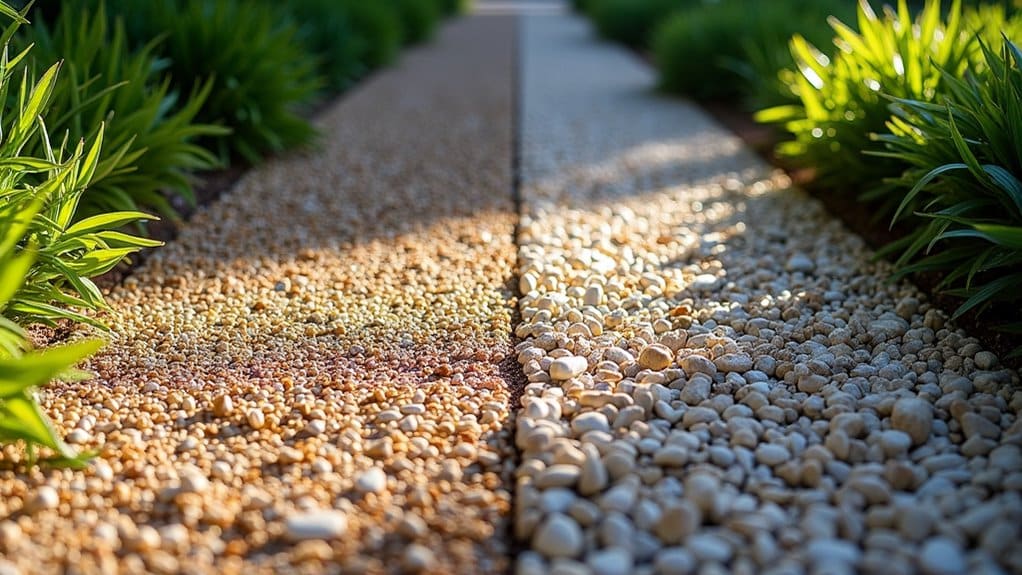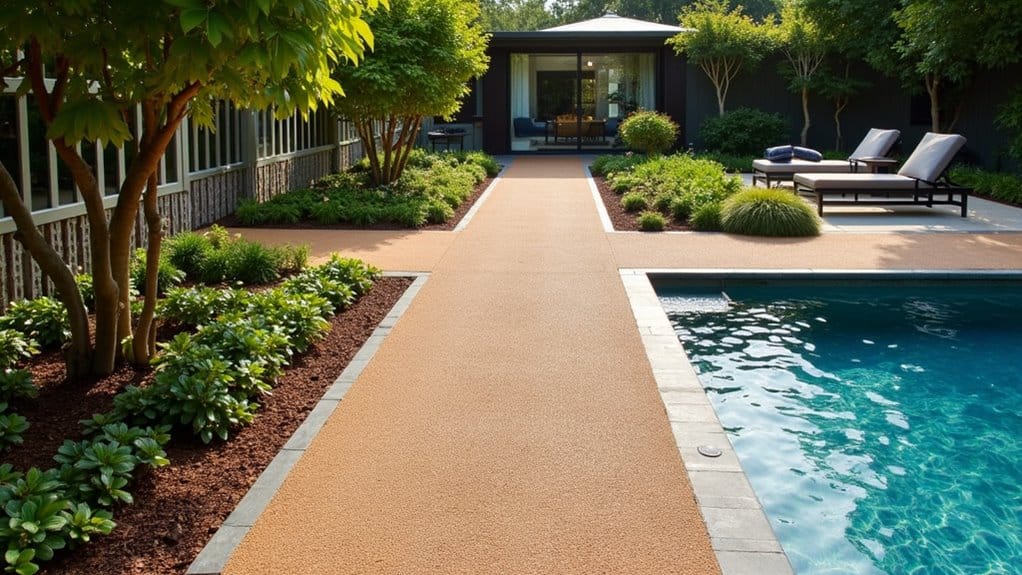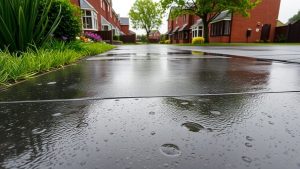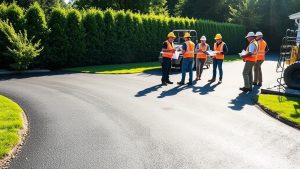When comparing resin bound and resin bonded gravel, there are key differences in both installation and performance. Resin bound gravel is created by mixing aggregates with resin, resulting in a smooth, durable surface that allows for effective water drainage. It is highly customisable and requires minimal maintenance.
On the other hand, resin bonded gravel involves applying resin to a base and then scattering loose stones on top. This creates a rougher texture that is more susceptible to weed growth and demands more upkeep. Furthermore, resin bound gravel complies with SUDS regulations, whereas resin bonded gravel does not. Understanding these differences will help you choose the right surfacing solution for your project.
Table of Contents
ToggleKey Takeaways
- Installation Method: Resin bound gravel mixes aggregates with resin for a smooth finish, perfect for driveways and patios. In contrast, resin bonded gravel involves applying resin to a surface and then scattering loose gravel on top.
- Surface Characteristics: Resin bound provides a smooth, permeable surface, making it suitable for high-traffic areas like pathways. Resin bonded, however, results in a rough texture, which can lead to water pooling.
- Maintenance Needs: With its smooth finish, resin bound gravel requires less upkeep. On the other hand, resin bonded gravel can trap debris, necessitating more frequent cleaning and weed control.
- Longevity and Durability: Resin bound gravel can last up to 30 years, making it a long-term investment. Resin bonded gravel typically has a shorter lifespan, influenced by the condition of the sub-base.
- Cost Differences: While resin bound gravel tends to be pricier, it offers better durability. Resin bonded gravel is more budget-friendly but may demand extra maintenance over time.
Overview of Resin Bound Gravel
Overview of Resin Bound Gravel
Have you ever thought about a surfacing solution that combines beauty and practicality? Resin bound gravel achieves just that by mixing natural aggregates with a clear resin.
The installation involves thoroughly combining your chosen aggregate with the resin to ensure each stone is fully coated for a smooth finish. This mixture is then evenly spread over a well-prepared base, such as macadam or concrete, resulting in a flat surface. The result is a highly permeable, water-draining surface that effectively manages rainwater. Additionally, the use of eco-friendly materials in the construction further enhances its appeal.
Selecting the right aggregate is key to both appearance and performance. You can personalise your surface by choosing from a variety of colours and types of aggregates to align with your design vision.
It’s important that the base is clean and dry to prevent issues like delamination. After mixing, the resin and aggregate are trowelled onto the surface for a tightly compacted application.
Once applied, the surface requires about four hours to cure, so it’s crucial to keep it undisturbed during this time.
This surfacing solution not only boosts the visual appeal of your property but also meets Sustainable Urban Drainage Systems (SUDS) regulations, making it an environmentally friendly option for any project.
Overview of Resin Bonded Gravel
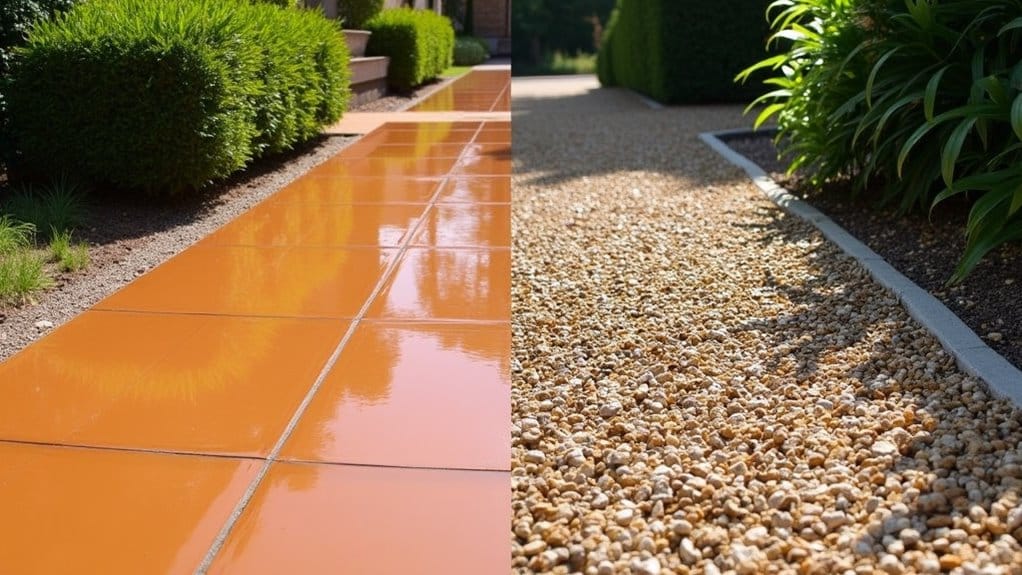
When exploring surfacing options, resin bonded gravel is notable for its appealing look and practical use. This method involves applying a layer of resin to a clean, dry base and then scattering loose gravel on top to create a textured finish that resembles natural gravel.
While it offers attractive aesthetic choices, there are significant installation challenges to consider. Installation must occur in dry weather to avoid problems like delamination. Choosing the right aggregate is crucial, as it affects both durability and appearance. It’s important to note that resin bonded gravel is non-porous, which means it doesn’t comply with Sustainable Urban Drainage Systems (SUDS) regulations. Additionally, it is essential to ensure the base material is in good condition before installation to prevent future issues. The non-porous nature of resin bonded gravel may contribute to weed growth in its loose structure, making regular maintenance necessary.
Maintenance is also a factor; the loose structure can lead to weed growth and stone displacement over time, so regular upkeep is necessary to keep it looking good and stable.
While it can be cost-effective for larger areas and allows for straightforward repairs, its durability may not meet long-term needs when compared to resin bound gravel.
Surface Texture Comparison

When comparing surface textures, resin bound and resin bonded gravel have distinct qualities. Resin bound offers a smooth, even finish which enhances durability, making it ideal for high-traffic areas. Additionally, the high porosity of resin bound allows for effective water drainage, further supporting its suitability for various applications. This seamless surface also inhibits the growth of weeds, moss, and algae, making it easier to maintain. In contrast, resin bonded has a textured look that resembles loose gravel, adding a natural aesthetic to your landscape. It’s important to understand these differences, particularly regarding maintenance needs and their overall effect on your garden design.
Texture Characteristics Overview
Resin bound gravel offers a smooth, flat finish, making it suitable for high-traffic areas such as commercial walkways. Its encapsulated aggregates provide durability and a permeable surface that allows water to drain through, reducing standing water. This allows for better SUDS compliance, ensuring that the area remains environmentally friendly.
However, this smooth texture may lead to slip resistance issues in certain conditions.
On the other hand, resin bonded gravel features a rough, textured surface that resembles loose gravel. This enhances traction, making it an excellent choice for driveways and paths where grip is crucial.
While it performs well in terms of slip resistance, its non-porous nature can cause water to pool, leading to moisture problems. Additionally, the loose aggregates require regular sweeping to keep the area clean, which can be a maintenance challenge.
Ultimately, your choice depends on your specific needs: whether you prefer a stylish, low-maintenance surface or require better grip in less-trafficked areas.
Aesthetic Appeal Differences
When comparing the aesthetic appeal of resin bound and resin bonded gravel, it’s clear that they cater to different design preferences.
Resin bound surfaces provide a smooth, flat finish, offering a seamless look that enhances visual harmony. This makes for a comfortable walking experience and allows for extensive colour customisation. You can choose from a wide range of colours and aggregate types that match your property’s style. Additionally, resin bound surfaces are known for their high resistance to cracking, ensuring that the attractive appearance is maintained over time.
On the other hand, resin bonded surfaces have a rougher texture, akin to loose gravel. While this uneven surface offers good slip resistance, it gives a more rugged appearance that may not suit every design aesthetic. The texture can vary, which can affect the overall look.
These surfaces are practical for pedestrian walkways where slip resistance is important, but they lack the aesthetic flexibility of resin bound options.
If you’re after a decorative and visually appealing finish that boosts your property’s curb appeal, resin bound gravel is the best choice. However, if functionality is your main concern, resin bonded gravel could meet your needs effectively.
Maintenance Impact Considerations
When considering maintenance, the surface texture of resin bound and resin bonded gravel plays a crucial role in their upkeep and longevity.
- Resin Bound Gravel: Its smooth finish minimises dirt build-up, making it easy to clean—usually, a light pressure wash will do the trick. It’s also resistant to weeds, meaning less frequent maintenance. With its durability, it typically faces fewer installation issues over time, which is attributed to its fully permeable nature that allows water to drain effectively.
- Resin Bonded Gravel: This option has a textured surface that can trap debris and promote weed growth. While it offers good slip resistance, it requires more maintenance to keep it safe and functional. The texture can lead to quicker wear and tear, affecting its long-term performance.
- Cleaning and Maintenance: The quality of installation impacts both types, but the challenges associated with cleaning resin bonded gravel can make it less suitable for high-traffic areas. Regular maintenance is essential to maintain both aesthetics and safety.
Permeability Differences

When comparing the permeability of resin bound and resin bonded gravel, it’s evident that these two systems have distinct functions.
Resin bound gravel is designed for excellent drainage, allowing water to flow through its porous surface. This makes it ideal for sustainable urban drainage systems (SUDS), as it reduces puddling and minimises the risk of flash flooding. In permeability tests, resin bound gravel significantly outperforms traditional materials, facilitating quicker groundwater infiltration and relieving pressure on municipal drainage systems. Additionally, the permeable nature of resin bound gravel promotes tree health by enhancing water and nutrient absorption.
On the other hand, resin bonded gravel is non-permeable due to its thick resin layer, which blocks water penetration. While this can be beneficial in areas needing slip resistance, like ramps, it isn’t suitable for flood-prone regions where permeability is crucial.
Using resin bonded gravel can worsen surface runoff issues, making it less ideal for locations that require effective drainage solutions.
Maintenance Requirements
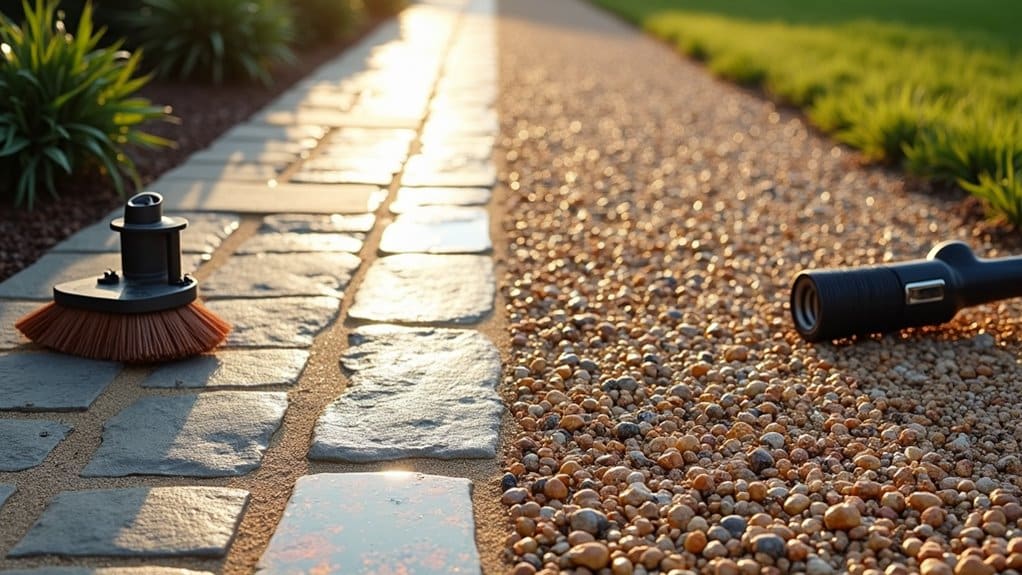
When considering maintenance requirements, it’s important to recognise the cleaning frequency and weed control needs for both resin bound and resin bonded gravel.
Resin bound surfaces typically require more regular attention to prevent weed growth.
In contrast, resin bonded gravel offers greater longevity and durability, needing less upkeep.
Understanding these differences can aid you in selecting the right option for your needs.
Cleaning Frequency Comparison
Maintaining a clean surface is crucial for both resin bound and resin bonded gravel, but the cleaning frequency and methods vary significantly.
For resin bound gravel, maintenance is fairly simple. Rainwater often helps keep the surface clean, but consider these effective cleaning methods:
- Light Pressure Washing: Aim for once or twice a year to remove residual dirt.
- Deep Cleaning: Use a fan nozzle with low to medium pressure (around 150 bar) to tackle stubborn stains.
- Spill Management: For oil spills, apply a de-greaser and rinse well.
On the other hand, resin bonded surfaces need more frequent manual upkeep due to their uneven texture. Here are some tips:
- Regular Sweeping: Sweep regularly to prevent dirt build-up.
- Avoid Pressure Washing: This can damage the non-permeable surface.
- Inspect After Rain: Check for loose aggregate after heavy rainfall.
Weed Control Needs
Understanding the cleaning requirements for resin bound and resin bonded gravel is essential for effective weed control. Resin bound gravel is generally more resistant to weed growth, necessitating less maintenance. Its solid surface inhibits root penetration, depriving seedlings of water. On the other hand, resin bonded gravel may need more regular cleaning due to its texture, which can allow for greater weed growth.
| Weed Control Needs | Resin Bound Gravel | Resin Bonded Gravel |
|---|---|---|
| Weed Prevention Techniques | Regular brushing and occasional herbicide application | More frequent cleaning required |
| Ecological Impacts | Meets SUDS regulations | Higher chance of weed growth |
| Maintenance Frequency | Minimal; occasional hand removal | More frequent due to surface texture |
Longevity and Durability
Longevity and durability are crucial when deciding between resin bound and resin bonded gravel, as both have unique maintenance needs that influence their lifespan.
Resin bound gravel can last up to 25 years with proper upkeep, while resin bonded gravel’s lifespan depends on the condition of the sub-base.
Here’s a straightforward comparison of their durability based on maintenance:
- Resin Bound Gravel: Needs regular cleaning, such as sweeping and occasional pressure washing. Resealing is essential to maintain its longevity.
- Resin Bonded Gravel: Requires less maintenance due to its non-permeable nature but still benefits from occasional brushing to prevent dirt accumulation.
- Environmental Considerations: Resin bound systems comply with SUDs regulations, minimising environmental impact, whereas resin bonded gravel lacks permeability.
Both options are durable, but the permeability of resin bound gravel demands more frequent maintenance.
If you prioritise longevity, be prepared for regular upkeep with resin bound gravel, while resin bonded gravel offers a more low-maintenance solution.
Your choice should align with your specific needs and willingness to maintain.
Durability Assessment
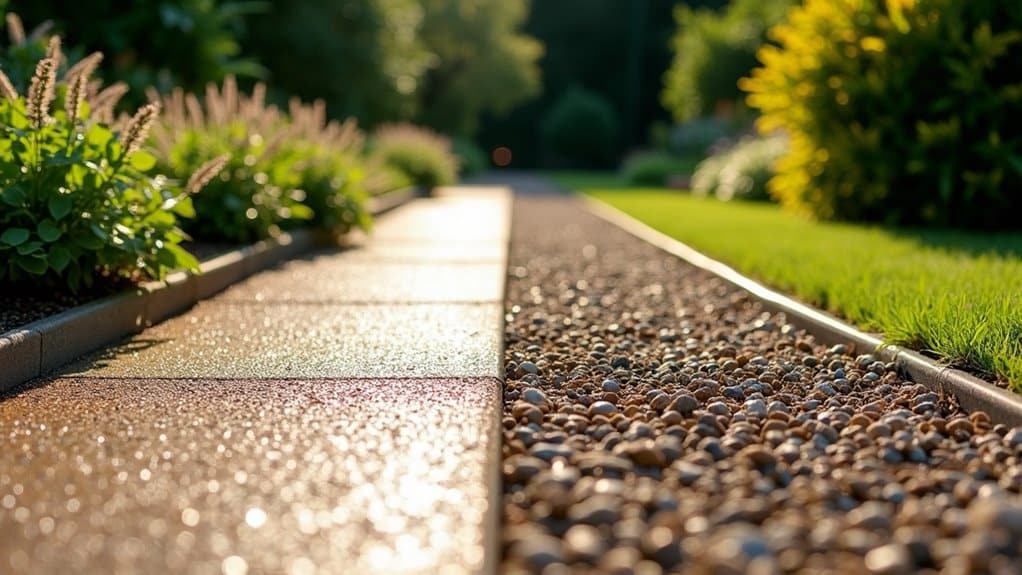
When considering the durability of resin bound gravel, it offers a remarkable lifespan of up to 25 years with proper care. High-quality resin can even extend this to 30 years, significantly outlasting many traditional materials. Its UV-stable and non-yellowing properties ensure that the surface maintains its appearance over time.
The installation process is vital for achieving top durability. Proper substrate preparation and accurate mixing are essential for a stable surface. A well-mixed application reduces the risk of cracking or displacement, making resin bound gravel more resilient than resin bonded options.
To keep your surface in good condition, follow maintenance tips like regular cleaning and debris removal. This helps prevent wear and maintains the integrity of the material. Always adhere to manufacturer guidelines to maximise longevity.
Factors such as UV exposure and extreme temperatures can affect durability, so it’s wise to include these considerations in your maintenance routine. By paying attention to these details, you can ensure your resin bound gravel remains robust and enduring for years to come.
Environmental Benefits

When choosing a paving solution, it’s important to consider the environmental advantages of resin bound gravel compared to resin bonded options. This choice supports sustainability and meets key environmental regulations.
Here are three main benefits of resin bound gravel:
- Permeability: Resin bound gravel allows water to drain through, which helps reduce flooding and prevents pollutants from reaching drainage systems. This feature supports healthy ecosystems and complies with Sustainable Urban Drainage Systems (SUDS) regulations.
- Recyclability: The materials in resin bound gravel can be reused or made into aggregates for other projects. This reduces waste and supports eco-friendly landscaping, contributing to the overall sustainability of your development.
- Low Maintenance: Resin bound surfaces require minimal upkeep, which means less reliance on chemical cleaners and weed killers. This not only lessens your environmental impact but also promotes a healthier environment by facilitating natural water drainage.
Application Methods Explained

Understanding the application methods for resin bound and resin bonded gravel is crucial for achieving the best results in your project. Each technique has its own specific requirements and processes.
Here’s a concise comparison of the two methods:
| Technique | Resin Bound | Resin Bonded |
|---|---|---|
| Base Requirements | Stable, clean surface | Clean, dry surface |
| Mixing Process | Mix aggregates with resin in a mixer | No mixing; apply resin first |
| Application Method | Spread and smooth with a trowel or spreader | Spread resin, then scatter loose stone |
| Curing Time | Around 24 hours | Varies with conditions |
| Finish Characteristics | Smooth and permeable | Textured and non-permeable |
In resin bound systems, you combine aggregates with resin to ensure an even mix, which helps prevent colour discrepancies. In contrast, resin bonded methods involve applying the resin directly to the base and then scattering the stone on top. Both techniques require meticulous attention to detail and adherence to proper application methods to achieve the desired finish and longevity.
Installation Considerations

When installing Resin Bound or Resin Bonded systems, it’s crucial to focus on base preparation to ensure stability and durability.
The installation process differs significantly between the two methods, impacting how you manage materials and tools. For instance, Resin Bound requires a well-compacted base, while Resin Bonded may need a more porous surface.
Additionally, be aware of the variations in curing times; these can affect the overall finish and longevity of your installation. Proper attention to these details will help you achieve the best results and avoid future problems.
Base Preparation Requirements
Proper base preparation is crucial for ensuring the durability and stability of resin bound surfaces. Here’s how to establish a solid foundation:
1. Material Considerations: If you want a fully permeable surface, remove any existing tarmac or concrete.
For non-permeable installations, check that the current material is in good condition. Avoid unstable block paving as it can compromise the surface.
2. Preparation Steps: Begin by excavating the area to a depth of 150-220mm, depending on the ground’s firmness.
Lay a compacted sub-base using MOT Type 1 stone, and include a geotextile membrane to prevent weed growth and sand wash-out.
3. Base Quality and Stability: Ensure the base is clear of cracks, standing water, and loose materials.
Compact it thoroughly to create a strong foundation that supports effective drainage. Regular checks are vital to spot any issues before installation.
Laying Process Differences
Understanding the differences between the laying processes for resin bound and resin bonded gravel is crucial for achieving the best results.
For resin bound gravel, you begin by mixing resin with stone aggregate, ensuring that each stone is evenly coated. This mixture is then spread to the desired depth, requiring careful attention to level and smooth the surface using a trowel or roller.
Proper compaction is essential for a long-lasting finish.
On the other hand, resin bonded gravel involves applying the resin directly onto the base surface first. You then scatter the stone aggregate over the wet resin, which uses the resin’s adhesive properties to secure the stones in place.
It’s important to measure both the resin and stone accurately to ensure proper adhesion and avoid issues like stone loss over time.
Both methods require careful preparation and the right tools, such as forced-action mixers for larger areas.
Curing Time Variations
Curing time variations are crucial for the performance and durability of resin-bound and resin-bonded gravel installations. Understanding these differences can help you make informed decisions during installation.
Here are the main factors affecting curing times:
- Weather Conditions: Drying times are significantly influenced by the weather; heavy rain can extend the curing period.
- Temperature Range: Optimal curing occurs between 5°C and 25°C. Outside this range, you may encounter difficulties.
- Layer Depth: The thickness of the resin layer affects the curing speed.
For resin-bound systems, curing generally takes 6 to 12 hours in warm weather, while cold conditions can stretch this to 48 hours.
Conversely, resin-bonded surfaces become touch dry in just 3-4 hours and fully cure within a day at 20°C.
It’s advisable to consult your contractor for guidance on curing practices. They can help identify signs of complete dryness and suggest catalysts to accelerate curing in cooler temperatures.
It’s important to avoid using the surface prematurely to prevent cracking or deformation, ensuring your installation remains robust and effective.
Base Preparation Needs

When preparing a base for resin bound gravel, it’s crucial to ensure it meets specific material and condition requirements for optimal results.
Start by choosing a stable base material, such as concrete, tarmac, or compacted Type 3 aggregate. Avoid block paving, soil, or grass, as they lack the necessary stability.
Thoroughly inspect the base and clean it effectively using a pressure washer to remove dirt, debris, or contaminants. Fill any cracks or holes to create a smooth surface, and if needed, apply a primer to enhance adhesion.
The base must be clean, level, and free from grease or standing water before laying the gravel.
If the base is loose or unstable, consider using a stabilising mesh and compacting the surface to improve uniformity.
Always ensure the base is dry and avoid laying the gravel during rain or when wet conditions are predicted.
Curing Processes

Achieving a successful cure for resin bound and resin bonded gravel surfaces relies on several key factors that ensure durability. Understanding the curing techniques and environmental influences is vital for optimal results. Here’s what to consider:
1. Temperature Effects: The ideal curing temperature is between 5 to 35 degrees Celsius. Warmer temperatures can speed up curing, whereas cooler conditions may prolong it beyond 48 hours.
Be sure to check ground temperatures, especially in winter.
2. Environmental Conditions: Humidity and moisture significantly impact curing rates. Installing in high humidity or frost can lead to surface separation.
Keep an eye on the weather forecast and avoid applying resin in direct sunlight on dark surfaces, as this can cause unexpected acceleration in curing.
3. Application Methods: How you mix and apply the resin is crucial. In resin bound systems, mixing the resin with aggregates ensures even curing, while resin bonded systems need careful scattering of aggregates.
Poor mixing can cause material failure, so regular checks are advisable.
Cost Implications

Understanding the cost implications of resin bound and resin bonded gravel is crucial for your project.
Resin bound gravel typically costs between £120 and £190 per square metre, including materials, base preparation, and labour. For an average driveway of about 50 square metres, expect to pay between £6,000 and £9,500.
In contrast, resin bonded gravel is generally more affordable, averaging around £87 to £151 per square metre. However, remember that labour costs for resin bonded projects are often additional, potentially adding £800 to £1,000 for a standard 15-hour job.
While resin bound gravel is pricier upfront, it offers greater durability.
Factors like location, surface conditions, and customization can also affect the total cost. Consider these elements carefully to find the option that best fits your budget and project requirements.
Frequently Asked Questions
Can Resin Bound Gravel Be Used for Driveways?
Yes, resin bound gravel is perfect for driveways thanks to its durable and permeable installation. To maintain it, simply sweep regularly and use a pressure washer occasionally to keep the surface clean and functional.
What Colors Are Available for Resin Bonded Gravel?
You have a range of colour options for resin bonded gravel, such as Autumn Quartz and Black Granite. These selections improve the look of your outdoor space, enabling you to create blends that complement your property’s exterior beautifully.
Is Resin Bound Gravel Suitable for Cold Climates?
Picture a winter landscape where your driveway gleams. Resin bound gravel can handle freezing temperatures, requiring minimal maintenance during winter to keep it looking its best. You can enjoy the cold knowing your surface can endure the challenges of winter weather with ease.
How Long Does Resin Bonded Gravel Typically Last?
Resin bonded gravel usually lasts between 5 to 10 years, depending on how well it’s installed and maintained. For example, if you prepare the surface correctly and keep up with regular upkeep, you can enjoy a sturdy and attractive surface for many years.
Can I Install Resin Gravel Myself?
Yes, you can install resin gravel yourself! With the right preparation and care, you’ll save money compared to hiring professionals. Just keep in mind that working efficiently and accurately is essential for a successful outcome.
Conclusion
When deciding between resin bound and resin bonded gravel, you’re selecting more than just a surface; you’re defining your outdoor space. Each option has its own benefits and drawbacks, particularly in terms of permeability and maintenance. Consider whether you prefer the smooth finish of resin bound gravel or the textured appeal of resin bonded gravel. Your choice will influence both the look and functionality of your area, so it’s essential to weigh your options carefully.
Prepare the perfect base for your resin bound stone installation and discover the crucial factors that ensure lasting durability.
Know where resin bound surfacing can transform spaces for both residential and commercial use, and discover the countless benefits that Read more
A stone carpet combines beauty and resilience in flooring, but what makes quartz floors uniquely beneficial? Discover the secrets behind Read more

